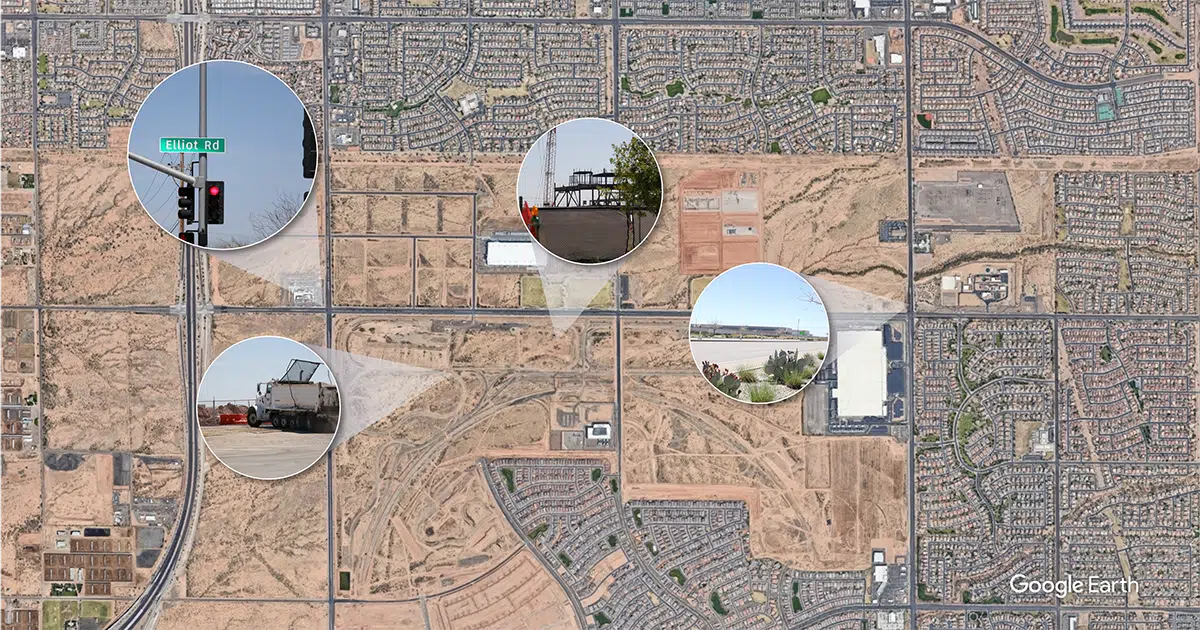

How Mesa’s Elliot Road Technology Corridor came to life
Published: 05/03/2023
Apple, Google and Meta chose the Elliot Tech Corridor in Mesa
The pitch to build in Mesa’s Elliot Road Technology Corridor today is a convincing one: Be where Apple, Google and Meta are expanding. Operate in close proximity to Arizona State University’s Polytechnic Campus and the Phoenix-Mesa Gateway Airport. Be part of one of Arizona’s largest and fastest-growing cities.
But a decade ago, coming out of the Great Recession, the five-mile east-to-west stretch was just land. DMB Associates purchased the former General Motors (GM) Desert Proving Grounds from GM in 2007 and sought the best way to develop during the Great Recession with help from regional leaders like Mesa Director of Economic Development Bill Jabjiniak and Greater Phoenix Economic Council President & CEO Chris Camacho.
“Chris and I were part of a strategic session with DMB Associates back then about what should they do with the property,” Jabjiniak said. “Chris suggested, ‘Why don’t we look at a tech corridor, you have a lot of natural resources there.’”
“Bill, DMB and I stood there on the hillside talking about the desert proving grounds of GM and what could become of a future technology corridor,” Camacho said. “Realizing where we were in the market cycle, coming out of Great Recession, we were seeing the beginning stages of pretty significant technology jobs, data centers, advanced manufacturing.”
With intentional planning, the group could invest in a base that attracts top tech companies. The requisite utilities already existed to supply the demands for such a corridor, with a Salt River Project (SRP) receiving station and massive amounts of power, fiber accessibility, sewage and a conduit underground. Empty land was plentiful.
“It’s getting ahead of what would be the demands of the companies before we even knew what the scope was going to be,” Camacho said.
Mesa studied corridors such as the Price Corridor Business District in Chandler and Data Center Alley in northern Virginia, seeking elements to implement that worked for these successful zones. The city added an innovative overlay that expedited the entitlement process to six weeks for companies that opted in. Signal Butte Water Treatment plant, which delivers 24 million gallons of water per day from Central Arizona Project (CAP), operates in the area and services nearby companies.
First Solar was one of the initial companies who committed to building in the area. In the early 2010s, solar projects were launching en masse with aims of revolutionizing the energy sector, and First Solar planned factories at Elliot and Ellsworth roads. Though the project stalled, it attracted the attention of other companies looking for expansion opportunities — namely, Apple.
The tech giant opened a data center operation in Mesa and later took advantage of the Foreign Trade Zone benefits, making it the company’s global command center. Today, companies in the tech corridor employ 5,700 people and occupy more than 3.6 million existing square feet, according to CoStar.
“With Apple talking across the world, it’s now about the Mesa Way,” Jabjiniak said. “After they got into their process and we showed how easy it is to work with us it, they started talking about, ‘Hey we did things in China and Asia and it’s really streamlined, but here, this is tremendous.’”
Google and Meta chose the Mesa Way as well, announcing additional anchor investments within the Elliot Tech Corridor. Amazon, Niagara Bottling and Edgecore are among companies operating or preparing to operate within the district, and in the corridor and its immediate surroundings is under construction while more than 6.8 million square feet is planned, according to JLL. A retail development with hospitality and plans for a medical office building has been approved by Mesa’s planning department. The space is alive with construction trucks leaving a trail of dust from one worksite to another, fenced plots of land poised for development, and cranes reaching into the sky all in a moment of defined growth for the City of Mesa.
“Arguably, the reason why Greater Phoenix has been under the microscope for technology job growth is we’re building commerce hubs that not only meet the speed and market needs for these companies, but they’re in areas that have rich labor pools,” Camacho said, citing areas including the Price Road Corridor, ASU Research Park and SkySong. “Success begets success, and when cities across the Valley see Elliot Tech Corridor being emblematic of job success, new tax revenue, more infrastructure, then you see this happening across the Valley.”
Mesa is now the second-largest city in Greater Phoenix, third-largest in Arizona and 36th-largest in the nation with approximately 500,000 residents. Long-term water sustainability is being addressed through a variety of means, including expansion of the Signal Butte Water Treatment Plant to be capable of treating 48 million gallons per day, construction of a 10.5-mile pipeline as part of a deal with the Gila River Indian Community, and co-ownership of the 91st Avenue Wastewater Treatment Plant in Phoenix.
Transportation infrastructure improvements in the area are streamlining commutes and cargo routes within the Mesa tech corridor. Ray Road’s expansion on the north side of the Gateway Airport and the additions to Interstate 24 allow employees and residents to move more freely in the area and connects the hub to the rest of Greater Phoenix.
The future of the corridor will be defined by semiconductors, electric vehicles and battery manufacturers. Tech is at the center of most modern industries, and Mesa leaders intentionally planned Elliot Tech Corridor to accommodate the needs of future companies expanding into the region.
“The tech corridor and the brands it’s attracted has changed the dialogue not just nationally but internationally,” Jabjiniak said. “When companies talk about Mesa and Apple in the same sentence or same paragraph, or Meta, or others and their continued expansion here … it’s helped us brand and establish ourselves on an international scale.”